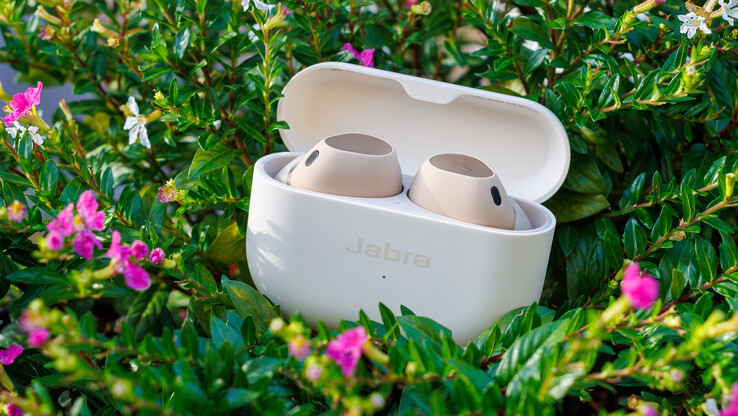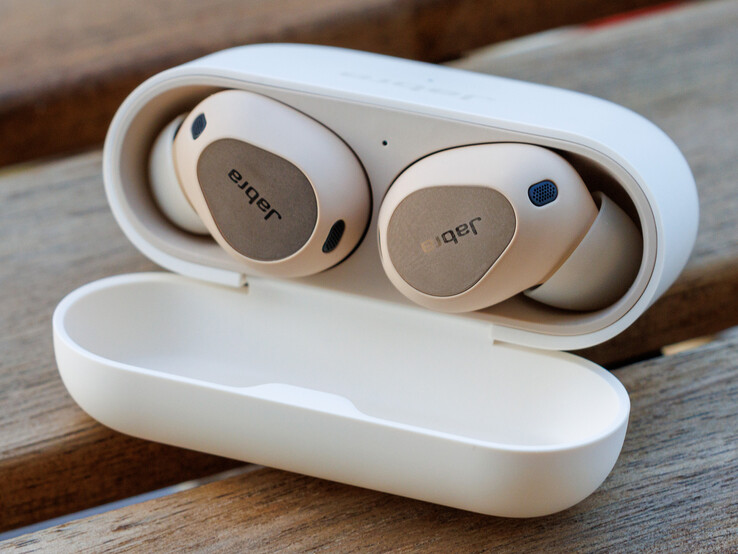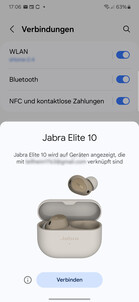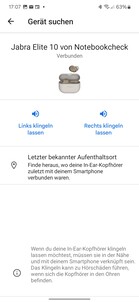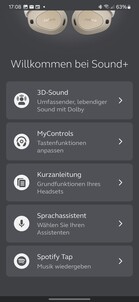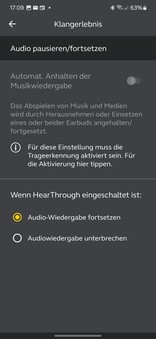Jabra Elite 10 review - Great-sounding in-ears featuring Dolby Atmos and head tracking
Jabra is not an unfamiliar face in the audio industry and is considered one of the leading manufacturers of professional headsets worldwide. With the true-wireless stereo (TWS) Elite 10, the Danish company is offering a pair of earphones in this class for the very first time. The Elite 10 features 3D sound with Dolby head tracking and is waterproof as well.
Jabra claims that its own Advanced Active Noise Cancelling technology is twice as powerful as conventional systems. Moreover, the Elite 10 wants to impress users with its battery life and connectivity.
Specifications
| Style | In-ear |
| Connectivity | Bluetooth 5.3 |
| Range | 10 m |
| Drivers | 10 mm, 20 - 20,000 Hz (music mode), 100 - 8,000 Hz (voice mode) |
| Audio codecs | SBC, AAC, (LC3 and LC3plus support will be added in future) |
| Battery life | not specified |
| Charging port | USB-C |
| Wireless charging | yes |
| Weight (earphone) | 5.7 g (0.2 oz) each |
| Weight (charging case) | 45.9 g (1.6 oz) |
| Firmware version | 1.3.6 (1031) |
| Box contents | Earphones, charging case, USB-C to USB-A cable, warranty information and leaflet with safety info, EarGels in 4 sizes |
| Price (RRP) | €250 (US$250) |
Case and ergonomics - Waterproof Jabra headphones
Both the charging case and earphones of the Jabra Elite 10 are made of plastic and available in the colours Cocoa, Cream, Gloss Black, Matte Black and Titanium Black. Everything looks and feels premium and well crafted. The earbuds are held securely in their wells by magnets built into the case. Wireless charging (Qi) is also supported. The wireless earbuds themselves have an IP57 rating, meaning they are waterproof and protected against the ingress of harmful amounts of dust. However, the IP rating doesn’t apply to the charging case.
Unlike the cheaper Elite 5, for example, the Elite 10 comes with not three but four pairs of ear tips for you to adjust the how the earbuds fit in your ear canals. Each earphone should be inserted into the ear canal with a gentle twist such that the earbud’s body is pushed partially behind the antihelix. This is going to ensure you get the most secure fit possible.
The Elite 10 is comfortable to wear in our opinion. The earbuds don’t apply too much pressure despite being noticeable. They have a very secure fit, meaning we never felt like we might lose them even whilst moving. Unlike on most in-ear headphones, the sound bores are not round but rather triangular with rounded corners. As a result, if you ever need new EarGels, you will certainly have to turn to Jabra for them. They are available in Cocoa, Cream and Matte Black and can be ordered directly from the company: a complete set with all four sizes costs roughly €15 (US$15). Similarly, replacement earbuds (€175, or US$175, for a pair) and charging case (€75, or US$75) can be purchased separately.
Features and operation - Jabra Elite 10 with dual-device connectivity
Because it supports Google Fast Pair, the Jabra Elite 10 is a breeze to set up on Android. The system will detect the earbuds immediately and prompt you to pair them with your device. Pairing also works well on Windows PCs thanks to Microsoft’s Swift Pair. Optionally, you can use the built-in buttons to manually start pairing the Elite 10 with any computer, tablet or smartphone. The Jabra headphones can remember up to ten devices and connect to two simultaneously. Jabra calls this Bluetooth Multipoint, but dual-device connectivity is really what’s behind it. You can also use just a single earphone (mono mode) and leave the other in the case.
The Jabra Sound+ app, available as a free download on the App Store and the Play Store, allows users to not only perform firmware updates but also configure features such as active noise cancellation (ANC), HearThrough and the equaliser. Spotify Tap is available as an option as well.
The Elite 10 also has in-ear detection, which automatically pauses media playback when one or both earbuds are removed from your ears. Furthermore, the device can automatically accept phone calls as soon as you put on one earbud. These features can be enabled and disabled independently of each other such that the in-ear detection is, for instance, only used for media playback.
Each earphone has a physical button that responds to one to three presses and can be assigned according to your needs. Besides controlling media and managing calls, you can use these buttons to activate a predefined voice assistant on the paired device.
Sound - Dolby Atmos support, LC3 arriving later
Jabra says that the Elite 10 offers the “ultimate sound”. Slightly exaggerated, but not wholly unjustified. This is because the Elite 10 indeed sounded exceptionally lively with a clear and transparent sound stage during our testing. We only wish that low frequencies had more oomph. Rock music and action-heavy films lack power when played over the earphones.
Then there is also Dolby Atmos, a technology that gives both music and films an noticeably better audio presentation and makes them sound fuller and more natural. The optional head tracking detects head movements and adapts the audio to make the listener feel as if the sound is always coming from the same direction. Whilst this feature works very well, it is also somewhat a matter of taste.
During phone calls in a quiet environment, the microphones on the Elite 10 make the user’s voice sound very natural. However, they aren’t particularly effective at suppressing ambient sounds, regardless of whether it’s voices or traffic noise. Although muffled, both types of noise remain fairly audible throughout.
Things are different with the Advanced ANC, which is enabled automatically during phone calls. It reduces noise very well and is considerably more effective when you aren't making a phone call – excellent performance for a pair of in-ears. The HearThrough function works well too, but it is accompanied by a noticeable static noise when used in a very quiet space. This noise disappears when there's more going on in the surroundings.
The Jabra Elite 10 only offers support for basic Bluetooth codecs (SBC and AAC) at the moment. That said, LC3 and LC3plus support are coming to the earphones via future updates.
| Loudspeakers | |
| THD | |
| Samsung Galaxy Buds2 Pro (RMS: -3.0 dBFS) | |
| Jabra Elite 10 (RMS: -3.0 dBFS) | |
| Huawei FreeBuds Pro 3 (RMS: -2.2 dBFS) | |
| THD+N | |
| Samsung Galaxy Buds2 Pro (RMS: -3.0 dBFS) | |
| Jabra Elite 10 (RMS: -3.0 dBFS) | |
| Huawei FreeBuds Pro 3 (RMS: -2.2 dBFS) | |
* ... smaller is better
THD (Total Harmonic Distortion): Harmonic distortion quantifies the distortion caused by non-linear components (harmonic content) in relation to the original signal. THD specifically refers to the fundamental component. It's important to note that while the term "distortion factor" is often used interchangeably, it actually refers to the overall signal, not just the fundamental component.
THD+N (Total Harmonic Distortion + Noise): This value is comparable to THD, but in addition to measuring the interference power of harmonics, it also takes into account the impact of noise as an effective value. For the measurement, a low harmonic sinusoidal signal (typically at 1 kHz and > 0 dB) is played back through the headphones under test. This signal is then recorded by a linear measuring microphone (placed at a measuring distance of approximately 0.40 inches) in an artificial head.
Both THD and THD+N values are expressed as percentages. The lower the value, the higher the fidelity of the signal.
Jabra Elite 10 audio analysis
(+) | speakers can play relatively loud (90.4 dB)
Bass 100 - 315 Hz
(-) | nearly no bass - on average 17% lower than median
(+) | bass is linear (2.6% delta to prev. frequency)
Mids 400 - 2000 Hz
(±) | reduced mids - on average 9.6% lower than median
(+) | mids are linear (6.4% delta to prev. frequency)
Highs 2 - 16 kHz
(±) | higher highs - on average 13.6% higher than median
(+) | highs are linear (6.2% delta to prev. frequency)
Overall 100 - 16.000 Hz
(±) | linearity of overall sound is average (22.2% difference to median)
Compared to same class
» 64% of all tested devices in this class were better, 6% similar, 30% worse
» The best had a delta of 4%, average was 24%, worst was 134%
Compared to all devices tested
» 64% of all tested devices were better, 6% similar, 30% worse
» The best had a delta of 4%, average was 24%, worst was 134%
Samsung Galaxy Buds2 Pro audio analysis
(+) | speakers can play relatively loud (95.6 dB)
Bass 100 - 315 Hz
(±) | reduced bass - on average 13.6% lower than median
(+) | bass is linear (2.1% delta to prev. frequency)
Mids 400 - 2000 Hz
(±) | reduced mids - on average 7.6% lower than median
(+) | mids are linear (5.7% delta to prev. frequency)
Highs 2 - 16 kHz
(±) | higher highs - on average 12.2% higher than median
(+) | highs are linear (5.2% delta to prev. frequency)
Overall 100 - 16.000 Hz
(±) | linearity of overall sound is average (18.3% difference to median)
Compared to same class
» 39% of all tested devices in this class were better, 8% similar, 53% worse
» The best had a delta of 4%, average was 24%, worst was 134%
Compared to all devices tested
» 39% of all tested devices were better, 8% similar, 53% worse
» The best had a delta of 4%, average was 24%, worst was 134%
Battery life - It keeps going and going...
Jabra hasn’t provided any information regarding the capacity of the battery in each earbud. Nonetheless, we know the charging case is equipped with a relatively large 680 mAH battery. The device conveniently supports wireless charging.
The Elite 10 lasted more than ten hours in our battery test, which was performed with volume adjusted to 65 dB(A) and noise cancellation enabled. But we must also mention that battery life may decrease if the ANC algorithm has to adapt to a louder environment.
| Battery Runtime - Spotify loop at 65dB/A (incl ANC) | |
| Jabra Elite 10 | |
| Samsung Galaxy Buds2 Pro | |
| Huawei FreeBuds Pro 3 | |
Verdict - Jabra Elite 10 puts up a good show
The Jabra Elite 10 is an excellent pair of premium in-ear headphones that offers Dolby Atmos as a standout feature. It also boasts highly effective active noise cancellation and a waterproof chassis, which lets you use the earbuds in the shower or other wet places.
The Jabra Elite 10 is a pair of modern true-wireless headphones with few flaws.
We are impressed by the sound quality, but it could use slightly more bass. What’s more, the Jabra earphones cut a great figure during phone calls and last a really long time at that.
The Elite 10 thus delivers an almost complete set of features and actually leaves nothing much to be desired. High-res audio codecs are the only thing missing from the Bluetooth earbuds right now, but LC3plus support is scheduled to arrive later via updates.
The Huawei FreeBuds Pro 3 and Samsung Galaxy Buds2, in particular, are two fantastic alternatives in this price range. The Jabra Elite 5 has a smaller feature set, but then again it also has a smaller price tag and supports aptX to boot.
Price and availability
Transparency
The selection of devices to be reviewed is made by our editorial team. The test sample was given to the author by the manufacturer free of charge for the purposes of review. There was no third-party influence on this review, nor did the manufacturer receive a copy of this review before publication. There was no obligation to publish this review. As an independent media company, Notebookcheck is not subjected to the authority of manufacturers, retailers or publishers.
This is how Notebookcheck is testing
Every year, Notebookcheck independently reviews hundreds of laptops and smartphones using standardized procedures to ensure that all results are comparable. We have continuously developed our test methods for around 20 years and set industry standards in the process. In our test labs, high-quality measuring equipment is utilized by experienced technicians and editors. These tests involve a multi-stage validation process. Our complex rating system is based on hundreds of well-founded measurements and benchmarks, which maintains objectivity. Further information on our test methods can be found here.


